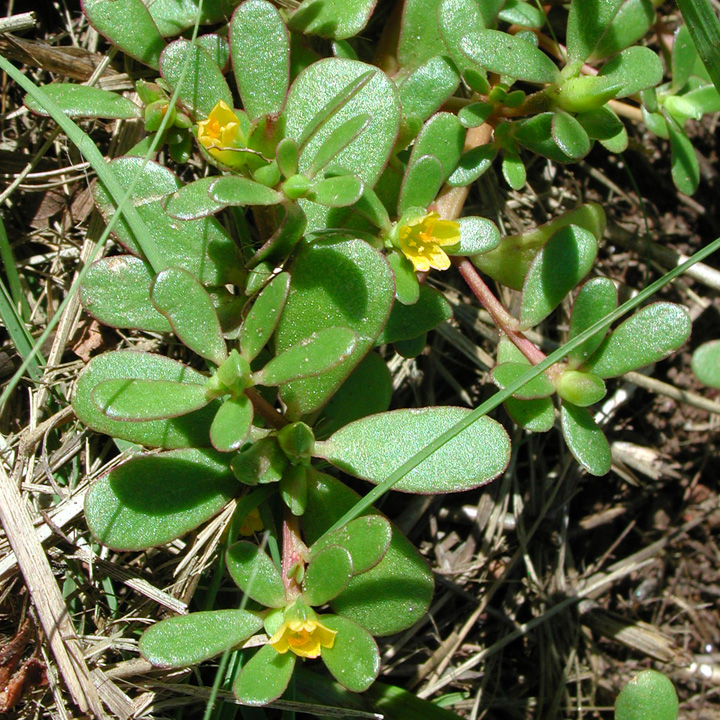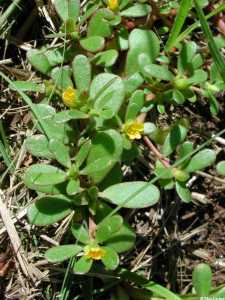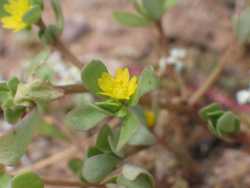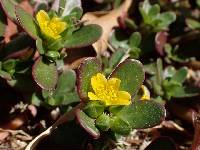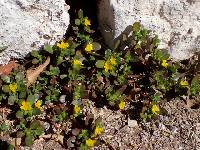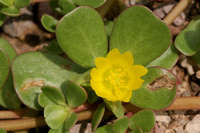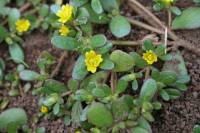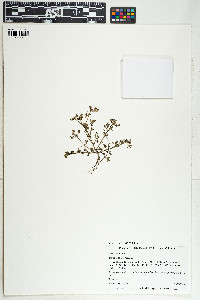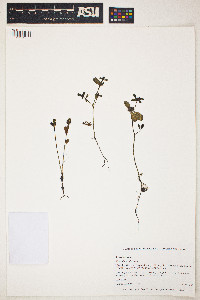Search
View the original page version
Portulaca oleracea
|
|
|
|
Family: Portulacaceae
little hogweed
[Portulaca neglecta Mackenzie & Bush, morePortulaca oleracea subsp. granulatostellulata (Poelln.) Danin & H. G. Baker, Portulaca oleracea subsp. impolita A. Danin & H.G. Baker, Portulaca oleracea subsp. nicaraguensis A. Danin & H.G. Baker, Portulaca oleracea subsp. nitida A.Danin & H.G. Baker, Portulaca oleracea subsp. papillatostellulata Danin & H. G. Baker, Portulaca oleracea subsp. stellata Danin & H. G. Baker, Portulaca retusa Engelm.] |
Plants: annual, glabrous; taproot 2-10 cm. Stems prostrate, succulent; trichomes at nodes and in inflorescence absent or inconspicuous; branches to 56 cm. Leaf Blades: obovate or spatulate, flattened, 4-28 × 2-13 mm, apex round to retuse or nearly truncate; involucrelike leaves 1-4. Flowers: 3-10 mm diam.; petals yellow, oblong, 3-4.6 × 1.8-3 mm; stamens 6-12(-20); stigmas 3-6. Capsules: ovoid, 4-9 mm diam. Seeds: black or dark brown, orbiculate or elongate, flattened, 0.6-1.1 mm; surface cells ± smooth, granular, or stellate, with rounded tubercles. 2n = 18, 36, 54. Flowering late spring-early fall. Fields, waste places; 0-2800 m; introduced; Alta., B.C., Man., N.B., N.S., Ont., P.E.I., Que., Sask.; Ala., Ariz., Ark., Calif., Colo., Conn., Del., D.C., Fla., Ga., Idaho, Ill., Ind., Iowa, Kans., Ky., La., Maine, Md., Mass., Mich., Minn., Miss., Mo., Mont., Nebr., Nev., N.H., N.J., N.Mex., N.Y., N.C., N.Dak., Ohio, Okla., Oreg., Pa., R.I., S.C., S.Dak., Tenn., Tex., Utah, Vt., Va., Wash., W.Va., Wis., Wyo.; Europe A. P. Simopoulos and N. Salem Jr. (1986) and A. P. Simopoulos et al. (1992) have shown Portulaca oleracea to have the highest content of omega-3 fatty acids and antioxidants of any green leafy vegetable examined to date, suggesting that common purslane should be considered for its nutritional value and not for its weediness. It has long been used as fodder and may have been present in the New World in pre-Columbian times (R. Byrne and J. H. McAndrews 1975). Currently, it is fed to poultry to reduce egg cholesterol. General Notes: Portulaca oleracea is a highly variable species with worldwide distribution in temperate to warm regions and is the most winter-hardy of all the portulacas. It is a very aggressive weed, one of the ten most noxious weeds worldwide (J. S. Singh and K. P. Singh 1967). As such, many variants have been named (C. D. Legrand 1962) based on seed surface differences, size of seeds, or on variable characters of growth habit, leaf length, and number of stamens. Seven subspecies were recognized by A. Danin et al. (1978): subsp. oleracea, subsp. impolita Danin & H. G. Baker, subsp. granulatostellulata Danin & H. G. Baker, subsp. nicaraguensis Danin & H. G. Baker, subsp. nitida Danin & H. G. Baker, subsp. papillatostellulata Danin & H. G. Baker, and subsp. stellata Danin & H. G. Baker. PLANT: Annual herbs from a taproot. STEMS: prostrate to somewhat ascending with radially spreading branches, 4-25 cm long or more often reddish, glabrous. LEAVES: alternate, flat, ovate-cuneate or spatulate, 10-17 mm long, 5-12 mm wide; nodes with a few inconspicuous hairs in the axils. INFLORESCENCE: glabrous or with a few inconspicuous hairs; involucral leaves 1-4, 6-20 mm long, 2-8 mm wide. FLOWERS: solitary or clustered at the ends of branches; petals yellowish, 2-5 mm long; stigmatic branches 3-6. CAPSULE: 2-6 mm in diameter; slightly stipitate. SEEDS: black, finely granulate, stellate, or rounded-tuberculate. NOTES: Disturbed areas, especially roadsides: reported from all AZ cos. except LaPaz; 450 - 2400 m (1400 - 7800 ft); Jun-Oct. Introduced. Worldwide in temperate to warm regions; throughout the U.S. (including AK) and Canada. Young leaves and stems edible raw or cooked. Portulaca retusa has been previously recognized as a separate species, based on seed morphological characteristics, growth habit, sepal shape, and number of stigmatic branches (Correll & Johnston 1970, W.B. McDougall 1973, Martin & Hutchins 2001, Kearney & Peebles 1960, Welsh et. al. 2003). Positive identification from herbarium specimens is only possible with mature seeds (roundedtuberculate vs. sharply echinate or stellate in P. retusa). Intergradation of seed morphological characteristics between the two species has also been observed. Other characteristics such as growth habit, sepal shape, and number of style lobes, previously thought to distinguish P. retusa from P. oleracea, have been found highly variable (Correll & Johnston 1970, Martin & Hutchins 2001, Kearney & Peebles 1960, Welsh et. al. 2003, W.B. McDougall 1973). More work, especially with fresh intact specimens, is needed to substantiate recognition of P. retusa at the specific level. REFERENCES: Allison Bair, Marissa Howe, Daniela Roth, Robin Taylor, Tina Ayers, and Robert W. Kiger., 2006, Vascular Plants of Arizona: Portulacaceae. CANOTIA 2(1): 1-22. Stem prostrate, usually purplish-red, glabrous, repeatedly branched, forming large mats, edible when young; lvs edible, succulent but flat, spatulate to obovate-cuneate, 1-3 cm, commonly rounded at the summit, the cauline alternate or occasionally opposite; fls solitary or in small terminal glomerules, sessile, self-compatible, yellow, 5-10 mm wide; sep ±acute; stamens mostly 6-10; style-branches 4-6; seeds with low, blunt tubercles, requiring light for germination; polyploid series on x=9. A cosmopolitan weed, probably originally native to s. Asia. All summer. Gleason, Henry A. & Cronquist, Arthur J. 1991. Manual of vascular plants of northeastern United States and adjacent Canada. lxxv + 910 pp. ©The New York Botanical Garden. All rights reserved. Used by permission. Wiggins 1964, Bair et al. 2006, FNA 2004, Heil et al. 2013 Duration: Annual Nativity: Native Lifeform: Forb/Herb General: Succulent annual herb from a short slender taproot and a few fibrous roots; stems prostrate or ascending, radiating out from the center of the plant to form a sprawling mat up to 60 cm wide; stems fleshy, glabrous, usually red. Leaves: Alternate or opposite along the stems; blades ovate to spoon-shaped, 3-30 mm long, succulent. Flowers: Solitary or in clusters of 2-5 at stem tips, each cluster of flowers subtended by a whorl of several leaves; sepals 2 per flower, fused at base, green or reddish; petals 5 per flower, yellow, 3-5 mm long. Fruits: Capsule ovoid to globose, 3-8 mm wide; splitting open so the top comes off like a pot lid (circumscissile) to release many tiny dark brown to black seeds, less than 1 mm long. Ecology: Found in open, disturbed locations, below 8,500 ft (2590 m); flowers June-October. Distribution: Cosmopolitan, on every continent in the world; throughout N. Amer. and in every state in the US. Notes: Portulacas in the southwest are small herbs with succulent leaves and stems, can have colorful flowers and possess capsules with few-many subtending leaves. This is the most weedy, widespread, most common species in the genus. It is a spreading annual with succulent, often reddish stems and opposite, succulent, spoon-shaped leaves; the flowers are small and yellow. It likes warm, sunny, open, disturbed areas including the edges of farm fields, irrigation ditches, and roadsides. It is commonly claimed to be non-native, but Flora of North America notes that it may have been present in North America in pre-Columbian times. Ethnobotany: The stems and leaves are edible raw or cooked, and are sold in grocery stores as purslane in the US and verdolagas in Latin America. The leaves have higher levels of omega-3 fatty acids and antioxidents than any other leafy green on the market, and the plant is fed to chickens to lower egg cholesterol. Etymology: Portulaca is from the Latin portula, little door, in reference to the the lid of the seed capsule; oleracea means of cultivation, vegetable, or edible. Synonyms: Portulaca neglecta; Portulaca retusa Editor: SBuckley 2010, FSCoburn 2015, AHazelton 2017 |
|
|
|

